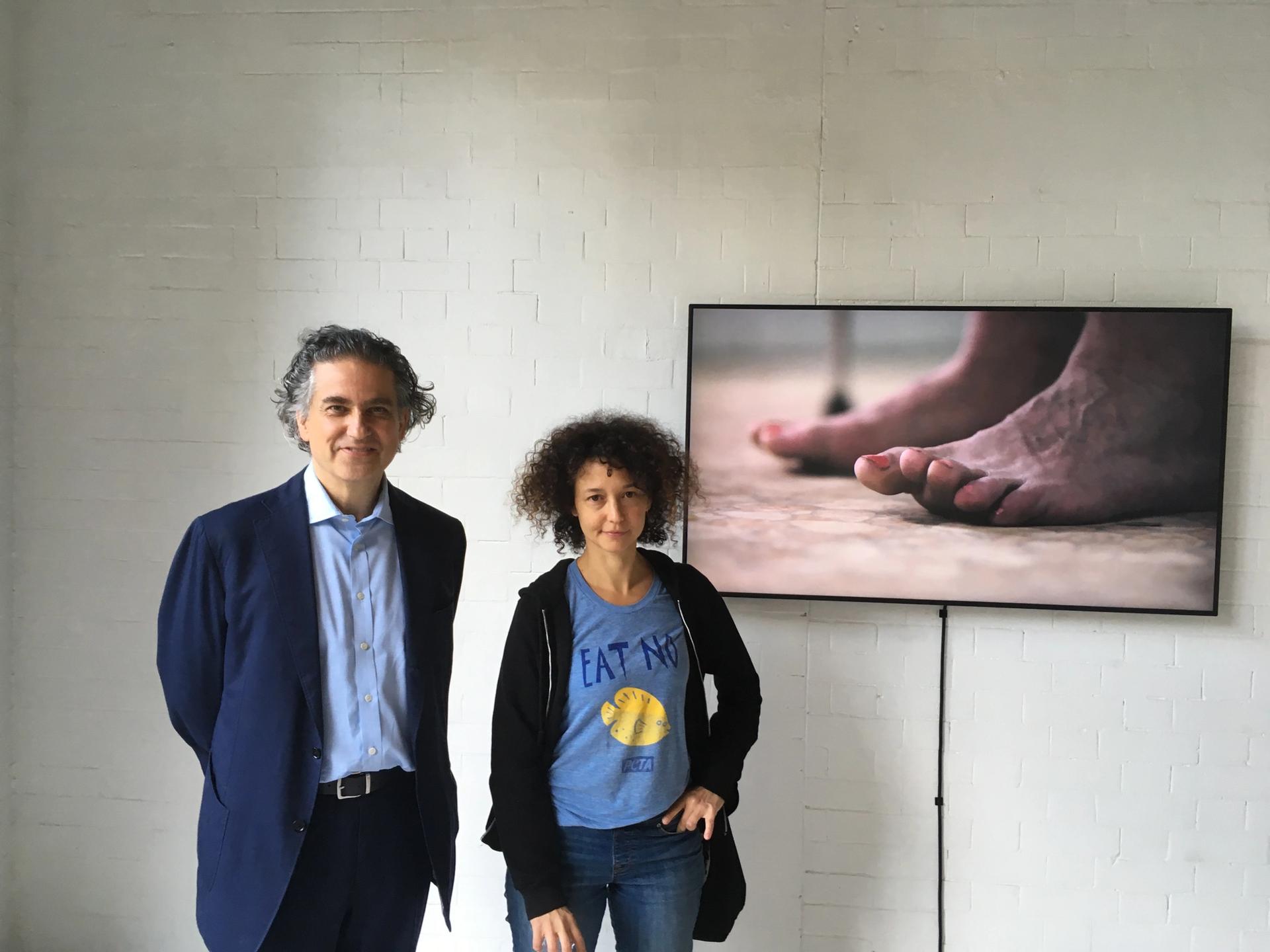The unveiling on Thursday (6 September) of the new Goldsmiths Centre for Contemporary Art (CCA) has been eagerly awaited and it didn't disappoint. The former Victorian bathhouse and water tanks situated in the middle of the London university's South London campus have been brilliantly and sensitively converted by the London based collective Assemble to produce a Tardis-like building with a deceptively spacious interior that yields up seven new gallery spaces with a dramatic two-storey event hall at its heart.
Yet while the London Borough of Lewisham now has an undoubtably world class art centre, Goldsmiths CCA doesn’t feel flashy or sterile. Its expanses of original tiled walls, exposed pieces of piping and the riveted steel tanks all bearing witness to the building’s initial role of providing bathing facilities to the surrounding low income communities.

Goldsmiths Professor of Curating Andrew Renton with Mika Rottenberg Courtesy of Louisa Buck
Unfortunately, however, more current matters of cleanliness cast something of a pall on the CCA’s opening events which were hijacked by a protest from Goldsmiths students demonstrating against the mistreatment of the university’s outsourced cleaning staff. In keeping with the Goldsmiths's long history of political activism, this small but persistent band of campaigners were permitted to provide a cacophonous backdrop to the proceedings, with Richard Noble, the head of the Fine Art department, stating that free speech and vociferous debate was the context in which the gallery had been conceived. At the CCA supporter’s dinner Patrick Loughrey, the Warden of Goldsmiths, was at pains to stress that all the university's employees deserved parity of rights and he believed a resolution was imminent.
Certainly a bit of background racket didn't deter the celebratory spirit and grand turnout of prestigious CCA supporters who made their way to South London to attend Thursday night’s early preview dinner. Among them was a multigenerational span of Goldsmiths alumni ranging from the octogenarian artist Bridget Riley, who was a student between 1949 and 1952 (and whose foundation has endowed one of the more substantial gallery spaces), through to mid-generationers such as Fiona Rae (classmate of Damien Hirst and the YBA crew), Gillian Wearing, Jane Wilson and Roger Hiorns as well as more recent 2007 graduate Adam Christensen, whose searing passionate vocals and swooping blasts of the accordion gloriously rounded off the evening.
The protests also did nothing to detract from the CCA director Sarah McCrory’s brilliant choice of Mika Rottenberg for the building’s inaugural show. Both physically and conceptually, the Argentinian-born, New York-based artist’s work translates perfectly to the CCA, animating and enhancing its somewhat labyrinthine spaces with her often elaborate films, installations and sculpture. These use humour but also a keen sense of the grotesque to deal with the precariously overloaded systems and excesses of our interconnected global economies. This includes the hidden female workforces perpetually feeding a decidedly alimentary consumer machine, whether as manicurists, subterranean pearl sorters or incarcerated in small spaces crammed with towering piles of trashy gewgaws. Sometimes they exist simply as surreal isolated elements: a single life-sized sculpture of a finger—complete with perfectly acrylic nail—protruding from a wall, or an auburn pony tail flicking convulsively back and forth with hysterical energy.
Not only does this bizarre parallel universe of consumer glut and punishingly repetitive toil have a direct affinity with the surrounding streets of Deptford and New Cross, which are awash with tacky discount stores and perpetually busy beauty salons and nail bars, but it also chimes loudly with the university’s current cleaning staff dispute. In fact, as soon as she became aware of the unfolding situation surrounding her first UK exhibition, Rottenberg made a point of declaring her “support and solidarity” with the Justice for Cleaners campaign. Despite the disruption of her exhibition she even went as far as to issue a statement endorsing the demonstrator’s decision to use the CCA opening night to promote their cause, expressing her hope that it will help “provide more visibility for the campaign as well as the debate around the connection between art and activism, ethics and aesthetics and the hypocrisies and contradictions that are part of our contemporary reality”. Magnanimity indeed, and an auspicious start for a gallery which has to consider all its surrounding communities.



